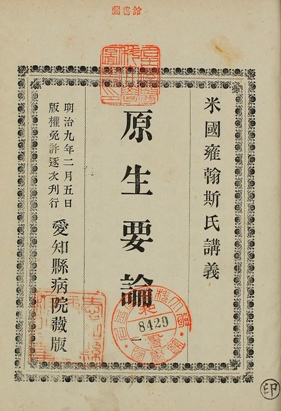 |
The Medical Museum of Nagoya University is located on the fourth floor of the Medical Library. It collects, preserves, and exhibits antique medical books, historical medical instruments, photographs and other items to promote understanding of the history of the Nagoya University School of Medicine in the context of the Tokai district and to look forward to the future of medical science. Parts of the collections can be accessed through the Digital Archive. Registration at the Medical Library counter is required for the actual use of these materials. |
|
4. Complications in the establishment of a school of Western medicine |
|
|
 |
"Gensei Yoron (Essentials of Physiology)" by T. H. JUNGHANS
In August Meiji year 4 (1871), a temporary hospital was established on the former site of the conference chamber of the Nagoya domain, and a temporary medical school was settled on the former site of the Town Magistrate's office. CHO Sangoku, a disciple of POMPE, was employed as a teacher, with SUZUKI Kozo as an assistant teacher. MIWA Tokuhiro (who later became president of Chiba Medical University), who entered the school at the age of 13, reminisced about those days as follows: "There were 20 to 30 students of various ages. The classes were not held regularly. Students gathered sporadically and studied however they felt like it. First the teacher would ask one of the students a question and when none of them could answer it, he would tell them the answer."
Unfortunately, the temporary hospital was closed during the process of prefectural reform in February, Meiji year 5 (1872) and the temporary school of medicine was shut down by Ordinances of the Ministry of Education based on "Gakusei Hanpu" (promulgation of the educational system) in August of the same year. Both had short lifespans of only a year, though the hospital resumed operation for a little while as an "Alms Clinic", thanks to contributions from donors, from that August to the following February.
ISEKI Moritome (1833-1890), Aichi's prefectural governor, adopted a policy to restore the hospital and school of medicine that was totally dependent on private sector vitality.
1) Collect private contributions of 10,000 ryo from 300,000 households in Owari and Mikawa
2) Appoint powerful farmers and wealthy merchants as the managers of the hospital
3) Appoint private-practice doctors who were former domain doctors, and who are sympathizers of the hospital's restoration, as hospital doctors
In May, Meiji year 6 (1873), Governor ISEKI restored the hospital at Nishi Hongwanji Betsuin and, in accordance with provisions of the Ordinance of the Ministry of Education saying "education shall be provided by foreign teachers", invited JUNGHANS, a German-American doctor, as a teacher, at a monthly salary of 400 dollars on a three-year contract. NAKAJIMA Sanhaku, a former court physician, was appointed as a hospital doctor. He contributed a comment to the Aichi Newspaper supporting the Hospital as follows:
"We have established this prefectural hospital and employed "Dr. JUNGHANS" as a teacher, which helps us constantly improve the hospital and its education. He is a great scholar and well known as an expert in academic research…Take lessons from him without delay. It is really most regrettable that people conventionally rely on Chinese Medicine, which is full of conjecture, and are skeptical of Western Medicine based on precise observation..." |
NAKAJIMA also drafted a proposal to establish a medical school at Governor Iseki's request, which begins: "Regarding the discussion that enables us to state the possibility of the establishment of a medical school without hesitation…". Accepting NAKAJIMA's proposal, a "medical training school" attached to the hospital was established, and classes taught in English began in November of the same year, Meiji year 6 (1873). However, it was really the following November that the class got on track. The details of the medical training school are unclear, except for a draft of its rules and copies of a textbook on natural sciences that bears the Aichi Hospital ownership stamp.
JUNGHANS performed skin graft surgery for a burn injury for the first time in Japan, and wrote "Gensei Yoron", which was the first academic book on Physiology published in the history of publications of the Nagoya University School of Medicine. However, as he was suffering from beriberi when his contract expired, he left the medical training school in April of Meiji year 9 (1876). Aichi Prefecture gave him a pair of cloisonné vases and 150 yen in recognition of his great achievements. |
|
|
|
|